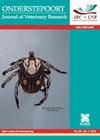波兰火鸡禽群中鼻气管炎鸟杆菌的发生
IF 1.6
3区 农林科学
Q2 VETERINARY SCIENCES
引用次数: 2
摘要
摘要鼻气管鸟杆菌(Ornithobacterium rhinotracheale, ORT)给世界范围内的家禽业造成了巨大的经济损失。这种细菌经常作为多重感染的一部分影响家禽,引起非常严重的临床症状,通常不仅限于呼吸系统。本研究的主要目的是回顾性检测和鉴定火鸡群中的ORT。材料与方法2015 - 2020年对133个不同禽群的6225份样本进行了ORT鉴定。采用分子方法,特别是实时荧光定量PCR和传统荧光定量PCR。我们将重点放在分离株的部分16S rRNA基因序列上,并与从GenBank中获得的序列进行比较。对反应产物进行了系统发育分析。采用分子方法提示继发性感染,对选取的鸡群进行上呼吸道细菌组成16S序列分析,以确定是否存在其他病原体。结果实时荧光定量PCR检测ORT的检出率为30.83%,PCR检出率为28.57%。从火鸡样品中提取的PCR产物的系统发育分析表明,它们的序列可分为两个主要的遗传群。继发感染的检测显示,在一些样本中存在鸡毒支原体和滑膜支原体,但完全没有禽博德特拉菌。火鸡的上呼吸道主要由厚壁菌门和变形菌门两大门组成。在属水平上发现鸟杆菌属、支原体属、Gallibacterium属、Avibacterium属和Escherichia-Shigella属,其中可能包括可引起临床症状的致病菌。结论在有呼吸体征的鸡群中进行的多重感染分析结果可能与波兰火鸡群中鸟类杆菌病的暴发有关。本文章由计算机程序翻译,如有差异,请以英文原文为准。
Occurrence of Ornithobacterium Rhinotracheale in Polish Turkey Flocks
Abstract Introduction Ornithobacterium rhinotracheale (ORT) causes significant economic losses to the poultry industry around the world. The bacterium often affects poultry as part of multiple infections causing very serious clinical signs that are usually not limited only to the respiratory system. This study’s main objective was the retrospective detection and identification of ORT in turkey flocks. Material and Methods ORT identification was performed in 6,225 samples taken from 133 different flocks between 2015 and 2020. Molecular methods were used, specifically real-time PCR and traditional PCR. We focused on partial 16S rRNA gene sequences of isolates, which were compared with sequences obtained from GenBank. The reaction products were analysed phylogenetically. Molecular methods indicating secondary infections was carried out, and the bacterial composition of the upper respiratory tract was 16S metasequenced for selected flocks to identify any other pathogens. Results The presence of ORT was detected in 30.83% of samples by real-time PCR and 28.57% by PCR. Phylogenetic analysis of the PCR products from the turkeys samples showed that their sequences resolved into two main genetic groups. Tests for the occurrence of secondary infections showed the presence of Mycoplasma gallisepticum and M. synoviae in some samples but the total absence of Bordetella avium. The upper respiratory tract in turkeys was dominated by two major phyla Firmicutes and Proteobacteria. At the genus level, the genera Ornithobacterium, Mycoplasma, Gallibacterium, Avibacterium, and Escherichia-Shigella were found which may include pathogenic bacteria that can cause clinical symptoms. Conclusion The results of the analysis of multiple infection carried out in flocks with respiratory signs are probably associated with outbreaks of ornithobacteriosis in turkey flocks in Poland.
求助全文
通过发布文献求助,成功后即可免费获取论文全文。
去求助
来源期刊
CiteScore
4.30
自引率
0.00%
发文量
13
审稿时长
16 weeks
期刊介绍:
The Onderstepoort Journal of Veterinary Research, is the official publication of the Onderstepoort Veterinary Institute. While it considers submissions from any geographic region, its focus is on Africa and the infectious and parasitic diseases and disease vectors that affect livestock and wildlife on the continent.

 求助内容:
求助内容: 应助结果提醒方式:
应助结果提醒方式:


